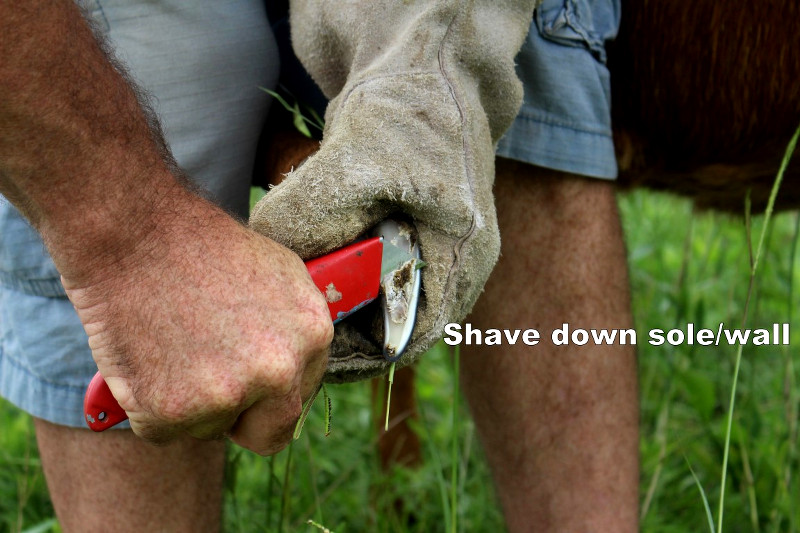
In the natural environments where goats evolved, traversing rocky land generally keeps their hooves in the proper length and shape. Domesticated goats are usually not so lucky, and so need help maintaining correct hoof length and shape for their comfort. How often you’ll need to do this depends on many factors, including breed and diet. The easiest way to know if it’s time for a trim is to lift a foot and check every now and then. If you wait until you see problems from above, with their feet still on the ground, you have probably waited too long. Hoof trimming is not the most fun, but it’s easy enough, especially if you keep up with it and don’t ever let the hooves get too bad. Here’s a quick guide on trimming goat hooves.
1. Assemble Your Tools
We use only three tools for trimming goat hooves: a heavy work glove, a pair of sharp pruning shears and a sharp box blade.
2. Secure Your Goat

We trim hooves on our milk stand (though for sanitation reasons, not while we are milking). Even if you don’t have dairy goats, it might be worth your while to build a basic stanchion for this and other health/maintenance tasks. If not, the next best thing is to clip the goat to a fence.
3. Inspect The Hoof And Set Your Goal
Look over the hoof and remember what you want it to look like when you’re done. When we first got goats, folks said to look at a kid’s hoof and use it as the ideal. When trimming goat hooves, you are looking to see a flat bottom with a clean sole (the soft middle part), surrounded by clean, even hoof wall.
4. Trim Flaps

Trim off any excess hoof wall that has grown, flap-like, over the sole. You can do this with either tool.
5. Start Shaving
Next, using long strokes of the box blade, sweep from heel to toe, shaving off the overgrown sole and wall together.

You are aiming to create a clean, flat surface and short enough so that you can see a blush of pink, the blood flow, beneath the surface.

If parts of the wall are pitted or filled with dirt/debris, you might need to pick it out prior to cutting. If there is pitting and a foul smell, you have some hoof rot. It can and should be treated with over-the-counter solutions if it is so deep that it cannot be safely cut away.
6. Trim Off Bulky Areas

Use your shears to trim off any bulky parts of the sole in the back and any extra growth between the two halves that keeps them from touching. If the toes look too long, you can use either tool to nip them back, too. Remember—the overall job needs to result in a flat surface, so don’t over-cut toes or heels. You might need to repeat the long, shaving cuts after this nipping.
7. Check Surface And Shape

When held together in your hand, the bottoms should look clean and even. When you set the foot down, the hairline above the hoof (the coronet) should line up parallel to the ground. If it is tilted either way, see if you can cut any more from the higher end, without losing a nice, flat surface on the bottom of the hoof.
While trimming goat hooves, you might not get every hoof perfect, every time. Mistakes that you make can be leveled out in future trims. You might—scratch that—you WILL sometimes cut too deep. (If it never happens to you, it is likely you are not trimming enough.) A small amount of blood is generally nothing to worry about. A cut that won’t stop bleeding with a little firm pressure and a few minutes of waiting might need a dose of blood-stop powder. We always keep some in our first aid kit, just in case.
One helpful tip: Hoof trimming is easier in wet weather, when the hooves have a chance to soften. It can be a real bear in long stretches of hot, dry weather. But again, if you keep up with trimming goat hooves, they are pretty easy to work. The hoof we used in these photos was more overgrown than we like them to get, but it shows how you can still get them back to shape. Don’t fear the hoof trim. Your goats will thank you when they have nice, comfy, flat feet.




